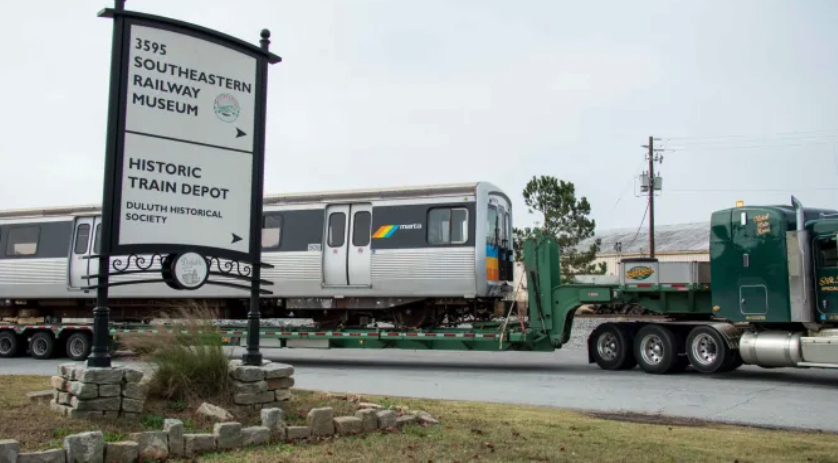
ATLANTA – The Metropolitan Atlanta Rapid Transit Authority (MARTA) has begun shipping old rapid transit MU cars to the Georgia coast and eventually the Atlantic Ocean. MARTA is partnering with the Georgia Department of Natural Resources Reef Project to contribute cars from MARTA’s original fleet as they are replaced by new CQ400 railcars in coming years. The Reef Project deploys large objects to the bottom of the ocean that over time develop into reef habitats for marine wildlife. [See, “MARTA unveils new cars, part of $646 million order,” News Wire, Dec. 16, 2022.]
Earlier this month the first two cars were stripped of hazardous materials and contaminants, then inspected and approved by the U.S. Coast Guard for deployment as artificial reef material. The first car was delivered to the East Coast Terminal in Savannah, Ga., Sept. 8, with the second scheduled to arrive Sept. 12.
“MARTA is thrilled to partner with DNR and be part of the Reef Project,” said Richard Thomas, MARTA director of sustainability, in a prepared statement. “Reefing is the most affordable and environmentally responsible way to reuse retired railcars, and we hope to provide more railcars in the future as we make room for the new trains.”
Once on the coast, the cars will be deployed by barge to Artificial Reef L, an established reef about two square miles in size, located approximately 23 nautical miles east of Ossabaw Island in about 55 to 65 feet of water.
Over time, the cars will provide essential habitat for sea creatures, including popular sport fish and endangered sea turtles. While the substrate for the reef is manmade, the organisms that will grow on it are entirely natural and beneficial for the environment. Fish and other marine life such as sea turtles are likely to investigate the new habitat almost immediately. Corals, sponges, and other encrusting organisms will begin to take hold on the cars in about a year and will continue to grow and improve the longer they are in the ocean.
The MARTA cars will join previously deployed materials, including U.S. Army M-60 battle tanks, barges, tugboats, New York City subway cars, and other manmade structures. Artificial Reef L was first created in 1976 as part of a network of 32 offshore reefs that the Coastal Resources Division has been building for about 60 years with an estimated 3 million square feet of reef created as of 2022.
To see how a MARTA car is prepared for reefing, click here.














I might also add that the Titantic is providing a monster feast and banquet for another form of marine life the rust eating worm who million of them are feasting on what is left of the Titantic and within a matter of a few years there will be nothing left of the Titantic except some parts that are resistant to salt water, rusticles or rust worms as they are called and any other natural elements in the ocean and for a short time a giant rust stain on the ocean floor which in time will also vanish forever.
Joseph C. Markfelder
A few years ago there was a documentary done on how the USS Oriskany was prepared for reefing as the term is called for using old ships, rail equipment and other vehicles as natural habitants for marine life. This is a great way to dispose of old railars and they have a second life in serving a new purpose. Even many years ago or hundreds of years ago this came about when old sailing ships that went down during storms or wartime conflicts were natural drwing places for marine life both plants and fish to settle on and populate and reproduce. Even the ocean liner Andrea Doria which sunk in 1956 after a collision with the liner Stockholm became a breeding ground for marine life. Old Spanish galleons that got sunk during hurricanes or storms have become marine life habitants. And this was long before mankind thought up this idea of reefing old transit and rail equipment for this purpose. Plenty of old aircraft sitting in boneyards that can be recycled also for marine life not to mention plenty of automobiles, trucks and buses as well sitting in junkyards and scrapyards which can also be recycled for this purpose.
Joseph C. Markfelder
Good video, can’t wait to see some pictures in a couple years.
“Cars will be part of reef restoration project” I had no idea you needed transit equipment for a proper reef. I’m guessing the cars were plucked from the reef when first born and are now being restored to their natural environment. That does explain the smell on board.
Anything of a permanent nature can be used as an artificial reef. Warships and other types of ships sunk at sea have been growing reefs for years. A few years ago, large holes were cut in the hull of the USS Oriskany, a Korean War/Vietnam War era aircraft carrier and it was sunk off of Florida to become a reef. It is a popular diving location and has already started to blossom with marine life seeking to find a hold on a solid object to grow.
These cars are dumped off barges and stay were they land. Old New York Subway cars, Penn Central Box cars with the doors removed and other types of items (like the M60 battle tanks mentions) are all piled up ion the bottom of the ocean floor at reef site L. It s is a great use for material that would be scrapped,, buried or left to rot in the desert as targets for the military to destroy. And the fish really benefit from the habitat that has been created.